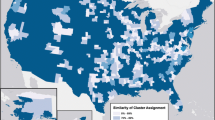Abstract
During the reform era, Chinese cities witnessed dramatic institutional transformation and spatial restructuring in general and profound change of commuting patterns in particular. Using household surveys collected in Guangzhou, China, in 2001, 2005 and 2010, excess commuting measurements are estimated. Excess commuting shows an overall trend of increasing during 1990–1999, and then declining during 2000–2010. We argue that deepening marketization of the jobs and housing sectors has induced spatial separation of jobs and housing. In other words, institutional transition and urban spatial restructuring are underpinning the changes of commuting patterns in Chinese cities. Excess commuting has strong relationship with individual socio-demographic status, which is by and large due to the increasing flexibilities of jobs and housing location choices enjoyed by urban residents. The findings call for considerations on balancing jobs-housing in making public policies relevant to urban development in general, and land use and transportation in particular.
Similar content being viewed by others
References
Björklund E M, 1986. The Danwei: socio-spatial characteristics of work units in China’s urban society. Economic Geography, 62(1): 19–29. doi: 10.2307/143493
Bray D, 2005). Social Space and Governance in Urban China: the Danwei System from Origins to Reform. Stanford, California: Stanford University Press.
Buliung R, Kanaroglou P S, 2002. Commute minimization in the greater Toronto Area: applying a modified excess commuting. Journal of Transportation Geography, 10): 177–186. doi: 10.1016/S0966-6923(02)00010-8
Frost M, Linneker B, Spence N, 1998. Excess or wasteful commuting in a selection of British cities. Transportation Research A, 32(7): 529–538. doi: 10.1016/S0965-8564(98)00016-0
Giuliano G, Small K, 1993). Is the journey to work explained by urban structure? Urban Studies, 30(9): 1485–1500. doi: 10.1080/00420989320081461
Giuliano G, 1991). Is jobs-housing balance a transportation issue? Transportation Research Record, 1305: 305–312.
Hamilton B, 1982. Wasteful commuting. The Journal of Political Economy, 90(5): 1035–1053. doi: 10.1086/261107
Horner M W, 2002. Extensions to the concept of excess commuting. Environment and Planning A, 34(3): 543–566. doi: 10.1068/a34126
Kim S, 1995. Excess commuting for two-worker household in the Los Angels metropolitan area. Journal of Urban Economics, 38: 166–182. doi: 10.1006/juec.1995.1027
Li S M, 2008). Urbanization and urban development in China. In: Li S M et al. (eds). Continuity and Change: Political Economy, Society, and Spatial Development of Contemporary China. Hong Kong: Hong Kong Educational Publishing Co., 348–382.
Li S M, 2010. Changing residential and employment locations and patterns of commute under hyper growth: the case of Guangzhou, China. Urban Studies, 47(8): 1643–1661. doi: 10.1177/0042098009356118
Liu Zhilin, Wang Maojun, 2011. Job accessibility and its impacts on commuting time of urban residents in Beijing: from a spatial mismatch a perspective. Acta Geographica Sinica, 66(4): 457–467. (in Chinese)
Liu Wangbao, Yan Xiaopei, Fang Yuanping, 2008. Related characteristics and mechanisms for excess commuting in Guangzhou. Acta Geographica Sinica, 63(10): 1085–1096. (in Chinese)
Ma L J C, 2004. Economic reforms, urban spatial restructuring, and planning in China. Progress in Planning, 61(3): 237–260. doi: 10.1016/j.progress.2003.10.005
Meng Bin, 2009. The spatial organization of the separation between jobs and residential locations in Beijing. Acta Geographica Sinica, 64(12): 1457–1466. (in Chinese)
Wang D, Chai Y, 2009. The jobs-housing relationship and commuting in Beijing, China: the legacy of Danwei. Journal of Transport Geography, 17(1): 30–38. doi: 10.1016/j.jtrangeo. 2008.04.005
Wang Fenglong, Liu Yungang, 2015. How unique is ‘China Model’: a review of theoretical perspectives on China’s urbanization in Anglophone Literature. Chinese Geographical Science, 25(1): 98–112. doi: 10.1007/s11769-014-0713-2
White M J, 1988. Urban commuting journeys are not ‘Wasteful’. The Journal of Political Economy, 96(5): 1097–1110. doi: 10.1086/261579
Wu F, 1997. Urban restructuring in China’s emerging market economy: towards a framework for analysis. International Journal of Urban and Regional Research, 21(4): 640–663. doi: 10.1111/1468-2427.00106
Yang Chai, Pu Yichao, Wang Chao, 2014. Excess commuting model with a consideration of resident income difference. Journal of Tongji University (Natural Science), 42(4): 564–569. (in Chinese)
Yang J, 2006. Transportation implications of land development in a transitional economy: evidence from housing relocation in Beijing, China. Transportation Research Record, 19(54): 7–14. doi: 10.3141/1954-02
Zhao P, Lu B, De R G, 2011. Impact of the jobs-housing balance on urban commuting in Beijing in the transformation era. Journal of Transport Geography, 19(1): 59–69. doi: 10.1016/j.jtrangeo.2009.09.008
Zhou Jiangping, Chen Xiaojian, Huang Wei et al., 2013. Job-housing balance and commute efficiency in cities of central and western China: a case study of Xi’an. Acta Geographica Sinica, 68(10): 1316–1330. (in Chinese)
Zhou J, Zhang C, Chen X, 2014. Has the legacy of Danwei persisted in transformations? The jobs-housing balance and commuting efficiency in Xi’an. Journal of Transport Geography, 40: 64–76. doi: 10.1016/j.jtrangeo.2014.04.008
Author information
Authors and Affiliations
Corresponding author
Additional information
Foundation item: Under the auspices of Ministry of Education of Humanities and Social Sciences Project (No. 09YJC840016), National Natural Science Foundation of China (No. 41001088), National Basic Research Program of China (No. 2014CB460614)
Rights and permissions
About this article
Cite this article
Liu, W., Hou, Q. Excess commuting in transitional urban China: A case study of Guangzhou. Chin. Geogr. Sci. 26, 599–608 (2016). https://doi.org/10.1007/s11769-015-0793-7
Received:
Accepted:
Published:
Issue Date:
DOI: https://doi.org/10.1007/s11769-015-0793-7




